Excerpts from Jim Conrad's
Naturalist Newsletter
from the July 17, 2016 Newsletter issued from Hacienda Chichen Resort beside Chichén Itzá Ruins; limestone bedrock; elevation ~39m (~128ft), N20.675°, W88.569°; central Yucatán state, MÉXICO
GUATEMALA GRASS
At the junction of the main highway between Mérida and Cancún and the little road leading into the hotel zone at Chichén Itzá, beside the asphalt someone dumped a load of broken floor tiles. An interesting grass has grown up amid the rubble. Below, you can see what this looked like on a recent foggy morning:
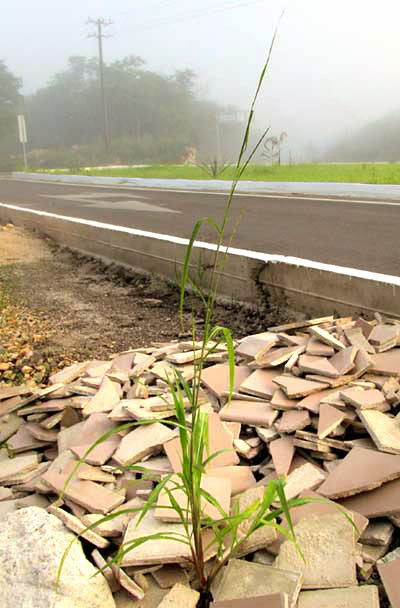
This grass caught my attention because its stem-top flowering cluster, or inflorescence, didn't look like anything else here flowering at this time. Up closer I saw that the inflorescence consisted of a few spikes held vertically, close to the stem, as shown below:
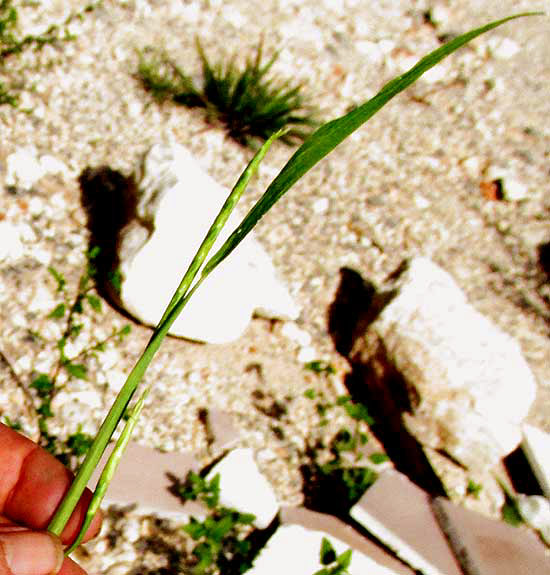
Up even closer the spikes themselves proved to be very unusual, looking like little green tin cans stacked atop one another, with a reduced leaf, or bract, on one side of each can, as seen below:
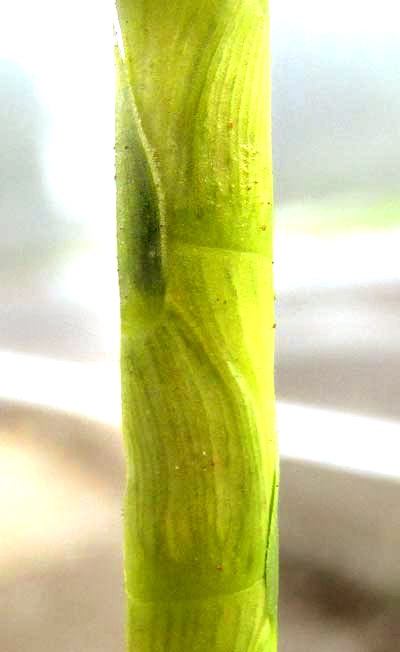
This is such an unusual configuration that when anyone who knows his or her grasses sees it, automatically the genus is recognized. It's the genus Tripsacum, whose species in English often are known as gamagrasses. Back in Texas we ran into a spectacular gamagrass of a different species, but still with tin-can spikelets, shown at www.backyardnature.net/n/h/gama.htm
The genus Tripsacum is a New World one embracing about 13 species, with a center of distribution in Central America. Only three species are listed for the Yucatan Peninsula, none occurring regularly and apparently none native; the few that have been collected on the Peninsula occur mostly in the southern part where it's rainier. Our rubble-living gamagrass seems to be a real accidental, maybe dumped where it's living along with the broken tiles, or maybe it arrived with the fill dirt that was deposited there by big dump-trucks when they upgraded the highway a few months ago.
If our rubble gamagrass is one of the three listed for our area, it's probably TRIPSACUM ANDERSONII, sometimes in English known as Guatemala Grass. The main field mark distinguishing Guatemala Grass from the other two species, and the Texas one shown at the above link, is that the bases of its flowering spikes don't cluster at the very top of the stem, looking like a bird's foot with widely spreading toes, but rather arise along the upper stem as well as its tip -- no spreading effect. Also, our rubble species has a ligule -- a collar-like growth at the base of the blade where it connects to the sheath partly encircling the stem -- that's little more than a low rim from which arise very fine hairs, or cilia, as shown below:
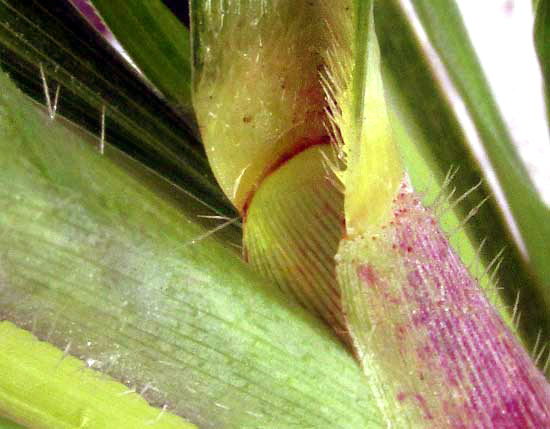
That picture also shows that the sheath is not densely soft hairy, but does bear scattered, long, stiff, broad-based hairs. Our plant's blades are short-hairy on top, but hairless below. Details of hair for the other species are somewhat different. One final field mark is that the male flowers -- normally occupying much or most of the flowering spike's length, and restricted to the top of the spike -- on our plant seem to be absent or so reduced in form that you doubt their ability to produce pollen. Below, you can see what I mean:
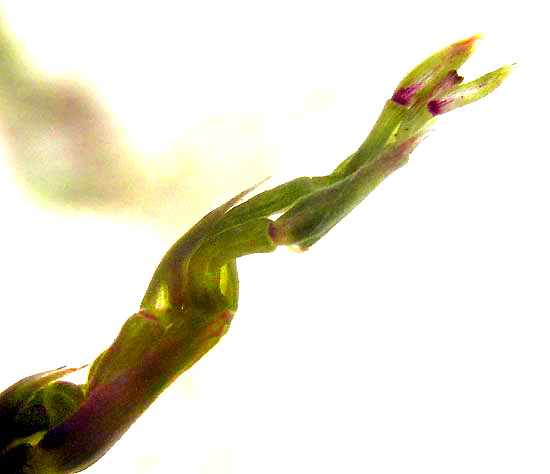
On the Internet I find pictures showing Guatemala Grass both with typical male flowers above the female one, and a few without male flowers, looking just like ours.
The lack of male flowers on our plant may be significant because Tripsacum andersonii is described as producing sterile seeds. A paper on the Internet explains that Guatemala Grass is a natural hybrid involving the genera Zea and Tripsacum. Zea is the genus for corn, or maize. It's not uncommon for hybrids to take place between different genera, and sometimes the hybrids are sterile. Guatemala Grass reproduces vegetatively, either from scattered pieces of its shallowly growing rhizomes, or from stem pieces, whose nodes easily root. "Always planted from stem cuttings with 3 nodes, rooted culms or rhizomes (800-3,000 kg/ha) at spacings of 0.5 m x 1 m. Can be cut 4-6 months after planting," says the no-nonsense TropicalForages.Info page on Guatemala Grass.
Guatemala Grass is grown in the humid tropics worldwide, where it's found to be especially useful as a green livestock feed during dry times. It makes a silage of moderate quality and can be grown as a "living fence," or kind of hedgerow, serving as contour strips to keep down erosion on hillsides, or as breaks to reduce insects and diseases from spreading across large monocultured fields.
It sounds like Guatemala Grass would be useful on ranchland in our area, which I personally think of as too arid for decent livestock production, but some people make the effort anyway. Maybe it was a rancher growing Guatemala Grass in his pastures who dumped the tile rubble at our intersection, in the process planting something interesting for me to find.